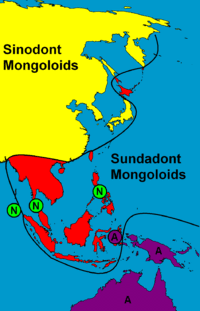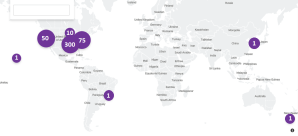 The out-of-Africa theory basically says that humans evolved in Africa, then spread in several pulses across the rest of the planet. The first hominin to leave Africa–as far as we know–was Erectus, followed by the Neanderthals/Denisovans, and finally Sapiens. Where exactly smaller, less well-known hominins like Homo Floresiensis fit into the picture we don’t know, yet.)
The out-of-Africa theory basically says that humans evolved in Africa, then spread in several pulses across the rest of the planet. The first hominin to leave Africa–as far as we know–was Erectus, followed by the Neanderthals/Denisovans, and finally Sapiens. Where exactly smaller, less well-known hominins like Homo Floresiensis fit into the picture we don’t know, yet.)
One of the incredible things about human evolution is just how many other human species we used to co-exist with. We shared this earth with at least 8 other species of human, met and mated with at least 4 of them. Before us came a proliferation of australopithecines.
Today, there is only us. This stunning diversity of upright apes has been winnowed to a single line. Species that had survived for thousands if not millions of years disappeared, either because they died out or were wiped out. We, sapiens, are the last ones standing.
Humans met Neanderthals. We interbred, briefly. Then the Neanderthals died out. Humans met Denisovans. We interbred, briefly. Then the Denisovans disappeared. Humans met so-called “Ghost populations” in west and southern Africa and interbred. The ghosts then disappeared. It’s all very mysterious how every other species of hominin and australopithecine seems to have died out immediately after we sapiens arrived in the area.
This implies, then, that sapiens didn’t live in these areas during the thousands or so years before we wiped out the locals (though some small exceptions may exist.)
So where did we live?
The West African Ghost Population contributed a big chunk of DNA to modern humans a mere 50,000 years ago–around the same time as sapiens were mating with Neanderthals. This seems to have been a much more significant encounter than the one with Neanderthals–perhaps many of these “ghosts” joined the sapiens who moved into their area.
So west Africa was likely not inhabited by modern humans before 50,000 years ago.
Homo naledi is too small to have co-existed with us, effectively ruling out their part of South Africa during that period, and the Pygmies probably interbred with their mystery hominin around 35,000 years ago, so that rules out the Congolese forest area.
The Neanderthal ancestry is in pretty much everyone not in Africa, (and a little in Africa due to recent back-migration) which is pretty strong support for the out-of-Africa theory. The most parsimonious explanation is that a single population split, and half of that population, as it entered Eurasia, encountered Neanderthals, while the other half traveled deeper into Africa and encountered African hominins.
East Africa/the horn of Africa region remains, therefore, the most logical spot to locate Homo sapiens immediately before this splitting phase, but I wouldn’t rule out the Middle East.
On the other hand, Homo sapiens’s ancestor, Homo heidelbergensis, lived in Africa, Europe, and the Middle East for thousands, possibly a million years (depending on how we classify the similar bones of Homo antecessor, who lived near Norfolk, England, about 950,000 years ago. Homo heidelbergensis’s (probable) ancestor, Homo erectus, lived in Africa, Europe, and Asia for over a million years.
Here’s where it gets complicated, because while species like the little hobbits from Flores are clearly different from other varieties of Homo, there are no clear dividing lines between folks like erectus, heidelbergensis, and ergastor. We have a bunch of bones, a few nice skulls, scattered across continents and centuries, from which we try to derive a vague sense of whether this population and that population were similar enough to consider them a single species. Quoting Wikipedia:
Although “Homo ergaster” has gained some acceptance as a valid taxon since its proposal in 1975, ergaster and erectus since the 1980s have increasingly come to be seen as separate (that is, African or Asian) populations of the larger species H. erectus. … The question was described as “famously unresolved” as of 2003.[10] Sura et al (2007) concluded that Homo erectus “was a likely source of multiple events of gene flow to the Eurasian continent”.[11]
The discoveries of the Dmanisi skulls in the South Caucasus since 2005 have re-opened this question. Their great morphological diversity suggests that the variability of Eurasian H. erectus already includes the African fossils dubbed H. ergaster. The discovery of Dmanisi skull 5 in 2013, dated to 1.8 million years ago, now dates evidence of H. erectus in Eurasia as of virtually the same age as evidence for H. ergaster in Africa, so that it is unclear if the speciation of H. erectus/ergaster from H. habilis took place in Africa or Asia.[12] This has reinforced the trend of considering H. ergaster as synonymous with H. erectus, a species which would have evolved just after 2 million years ago, either in Africa or West Asia, and later dispersed throughout Africa and Eurasia.[13][14]
Homo habilis, by contrast, is (so far) only found in east Africa.
What does it mean to evolve in a place? Habilis, as far as we know, actually did evolve in Africa. It didn’t leave Africa; neither did the australopithecines (unless one of those little hobbity folks out in the Philippines turn out to be australopiths, but that would be very remarkable). But after that, “humans” spread from Africa to Europe and Asia with remarkable speed. They lived in England almost a million years ago. And within this range, we seem to have become repeatedly isolated, speciated, and then met back up again when the weather improved.
Personally, I wouldn’t say that the out of Africa theory is wrong. It is still the most parsimonious explanation of human evolutionary history. However, I would say that it simplifies a huge chunk of our history, since for most of our time on this earth, our range has been quite a bit larger than Africa.





 (I have written
(I have written 




